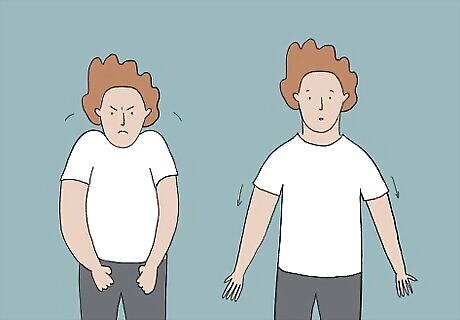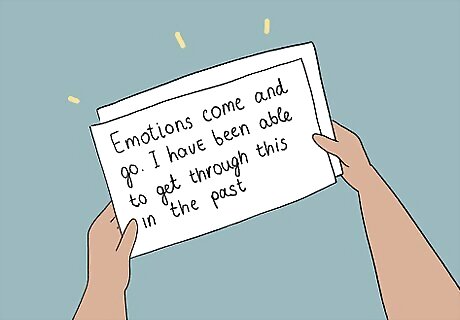
views
- Take slow, deep breaths to regain control in the moment. Count to 4 when you inhale, pause, and count to 4 as you exhale.
- Give yourself permission to work through an emotion privately instead of bottling it up. Set aside 15-30 minutes to sit with the feeling and then let it go.
- Express your feelings directly and confidently. To avoid conflict, use I-statements to communicate your points without blaming others.
- Remove yourself from negative situations that you can't resolve or work through, if possible.
Refocusing Your Mind and Body

Notice when you feel your emotions getting away from you. The first step to gaining control of your emotions is to recognize when they’re out of control. Ask yourself what this feels like physically and mentally, then work to identify it in the moment. Catching your emotions when they start to spiral requires mindfulness and conscious, rational thought. Just the recognition alone will start to ground you in the present moment. You might experience physical reactions like a faster heart rate, tense muscles, and rapid or shallow breathing. Mentally, you might start losing focus, feeling anxious, panicky or overwhelmed, or feel like you can’t control your thoughts. Slow down and focus on one element of your body’s reaction at a time. For example, if you’re suddenly feeling anxious, notice what that feels like in your body: “My heart is beating very fast. My palms feel sweaty.” Acknowledge and accept these feelings as they are, rather than judging them.

Breathe in deeply to calm yourself. When your emotions get away from you, your breathing will often get out of control as well, compounding your feelings of stress and anxiety. Cut off this spiral when you feel it happening by taking several deep breaths to calm down your mind and body. If you can, try a purposeful deep breathing technique for the most effective solution. To try this technique, first place one hand on your chest and the other below your rib cage. Inhale slowly and deeply through your nose for a count of 4. Feel your lungs and abdomen expand as you fill them with air. Hold the breath for 1 or 2 seconds, then slowly release the breath through your mouth. Aim for 6-10 deep breaths per minute. If a full 4-count is difficult for you, you can start with a 2-count and work your way up with practice. Just try to make your breaths as deep and even as you can.

Focus on physical sensations to recenter your mind. Losing control of your emotions can often come with a loss of self and place; you get wrapped up in your emotions and lose awareness of where you are. To counter this, force yourself to notice things directly around you or physical sensations you’re experiencing. Grounding exercises use most or all of your 5 senses to help root you in the present moment. Speaking aloud is especially important, as it shifts your brain away from your emotions. Coming back into your body and focusing on the present moment can help ground you and stop your emotional spiral. For example, look around and describe aloud what you see. Listen for any sounds you can hear, and state those aloud as well. Notice the smells in the area, and see if you can taste anything on your tongue. You might say, "The carpet and walls are different shades of blue, and the wall art is abstract with blues, reds, grays, and white. I can smell coffee brewing in the break room, as well as the smell of old file folders." Take notice of what it feels like to be sitting in your chair or holding your coffee mug. Notice how your clothes feel, if any muscles are sore or tense. You can focus on something as simple as your hands being in your lap. Brew a cup of hot tea and focus on the sensation of drinking it in this moment. How does the cup feel? How does it smell? How does it taste? Describe it aloud to yourself. Describe a painting aloud, listing as many details as possible. Carry an essential oil blend to smell when you feel stressed. Let the scent overtake you, and speak aloud about what you like about the scent.

Relax your muscles to relieve physical and mental tension. Do a scan of your body and see where you’re holding your stress, then force yourself to relax that area. Unclench your hands, relax your shoulders, and let the tension out of your legs. Roll your neck and shake out your fingers. Releasing physical tension can go a long way towards steadying your mind. If you’re having trouble relaxing your body, try a method like progressive muscle relaxation, or PMR. You’ll systematically tense and release your muscles in groups, starting at your toes and working upwards. Falling back on a set method like this can be useful when you can’t focus on finding specific areas of tension.

Visualize yourself in a calm, safe place. Choose a place, real or imagined, that you find tranquil and soothing. Close your eyes and imagine it, creating as many details as you can, while breathing slowly and evenly. Let out the tension in your body and let the calmness of your safe place quiet your thoughts and emotions. Your safe place could be a beach, a spa, a temple, or your bedroom—any place where you feel safe and relaxed. Think about the sounds you hear there, the things you’ll see, and even the smells and textures. If you can’t close your eyes or completely visualize your safe place, try to picture it quickly. Remind yourself of that calm, centered feeling and take a couple deep, quiet breaths. If you’re experiencing a negative emotion while you visualize, imagine it as a physical object that you can remove from your safe place. For example, your stress could be a pebble that you can throw away, imagining your stress leaving your body as you do so.

Create your own "Happy Book" or "Joy Box." Fill it with happy memories, such as photos and mementos, like a ticket stub to a favorite concert. Print out inspirational quotes you enjoy to add to your book or box. Include a gratitude list or journal, as well as items you find comforting. For example, your box could also contain a funny book, a few candies, a nice mug, and a box of tea. Pull out your book or box when you're feeling emotional. You can also create a digital version of your happy book with photos, memes, inspirational quotes, gifs, etc. that make you feel good.
Confronting Your Feelings

Identify what your actual emotions are. Learning to pinpoint and name your emotions can give you control over them when you feel like they’re running wild. Naming your emotions is actually a skill you may not have learned. Take a few deep breaths, then force yourself to look straight at the things you’re feeling, even if it’s painful. Then, ask yourself what the source of that emotion is, and if it’s covering up for something else that you’re afraid to confront. For example, ask yourself what about taking a major exam is making you so stressed. It might have a big influence on your future, or you feel like you have to do well to impress your family. At the root of your nerves might be a fear that your family’s love depends on your success. Remember that no emotion is “wrong.” Telling yourself not to feel something is a way of hurting yourself even more. Instead, notice the emotion without passing judgment. Accept that the emotion is natural and let yourself feel it. Imagine your emotion as a character who holds that emotion. Then, trace the emotion back to its root cause. Identifying and naming the true feelings behind your emotional turmoil gives you control over them. Now that you can identify the emotion for what it is, you know that it’s just a feeling, and that it doesn’t have to have any real power over you.

Give yourself permission to work through the emotion. Bottling up or ignoring your emotions will not make them go away. They will bubble up and resurface later, so it's important that you let yourself feel your emotions. However, you don't have to ruminate on them. Instead, set aside a block of time, such as 15-30 minutes to get out your emotion. For example, you might call a friend to vent or write out your thoughts in a journal. If you're feeling upset, you might take a moment alone to cry. If you feel the emotion in your body, such as with anger, stress, or envy, you might need to do something physical to work it out. You might go for a short walk or do yoga poses. EXPERT TIP William Gardner, PsyD William Gardner, PsyD Clinical Psychologist William Gardner, Psy.D. is a Clinical Psychologist in private practice located in San Francisco, CA’s financial district. With over 10 years of clinical experience, Dr. Gardner provides individually tailored psychotherapy for adults using cognitive behavioral techniques, to reduce symptoms and improve overall functioning. Dr. Gardner earned his PsyD from Stanford University in 2009, specializing in evidence-based practices. He then completed a post-doc fellowship at Kaiser Permanente. William Gardner, PsyD William Gardner, PsyD Clinical Psychologist Using a mood log from cognitive behavioral therapy helps decode emotions for better management. Record what triggered feelings, the emotions themselves, and your thoughts behind them. Over time, this builds understanding of how thought patterns shape reactions. That awareness fosters more positive thinking and behavior change.

Think about what you can do to resolve the situation. Sometimes, you may feel out of control emotionally because you can’t see how to control the situation around you. This can lead to “ruminating,” a “broken record” thought loop where you obsess about the negative thought or feeling in an unproductive, usually vague, way. Break this cycle by focusing on any specifics of the situation that you can address. Instead of ruminating about trouble at work by thinking, “Why am I so bad at my job?”, make a list of things that you can address. You might talk with your boss about how to increase your productivity, ask someone more experienced for help, or start trying different stress-management techniques. Work to accept the things that your own efforts can’t address. Letting go of the idea that you need to “fix” or “control” every element of a situation is a way to liberate yourself from stress and emotional turmoil.

Decide how to move forward in the best way you can. When you’re ready to decide on a course of action, make sure it’s a conscious choice, not a reaction to another, competing emotion. Think about how you want to resolve this situation and why. What values of yours does this response represent? Does it make sense rationally, too? Think about what your moral principles are. What do you want the outcome of this situation to be? What is the decision you'd be most proud of? Then, ask yourself which course of action is the most likely to result in the outcome you want. For example, if someone insults you, you could do nothing, respond aggressively, or firmly tell them to stop. Ask yourself how you want this situation to end, and how to get there without compromising the things you believe in.
Reacting to Your Emotions in a Healthy Way

Learn to recognize defensiveness in both yourself and others. Defensiveness not only leads to out of control emotions, it also makes people see you as too emotional. You may feel defensive if you feel stressed, frustrated, or personally attacked. However, it's important to listen to the opinions of others, especially if they're given constructively, without taking them personally. You can cope with defensiveness by reducing the threat in the situation and remaining curious about the thoughts of others. Here are signs of defensiveness: Refusing to listen to negative feedback Making excuses for failures Passing blame Crossing your arms to shut people out Smiling and nodding to get the person to stop talking Listing reasons why you're right without talking to others Ignoring feedback from others Using sarcasm or criticism of others to deflect from criticism about yourself

Take precautions against your emotional triggers. Your triggers are the activities, people, places, things, or events that consistently bring out particular emotions in you. Once you know your triggers, you can plan for them and mentally prepare yourself. For instance, let's say your sister makes you angry every time you see her. Before the next family gathering, you might engage in relaxing self care before you go, then plan how you will take breaks from your sister throughout the day. You might make plans with another relative to go do something, or you might plan to leave and pick up a dish. Limit how much time you spend with her, and plan a way to leave early, if necessary.

Do nothing if someone is trying to frustrate you. If you can tell that someone is bothering you just to egg you on, take a deep breath and stay calm. Speak calmly and refuse to let them get to you. When you maintain your cool, the person egging you on will become frustrated and eventually stop. When you feel ready to address them, first calmly tell them what you’re feeling. Say something like, “I get frustrated when I feel like you’re just trying to get a rise out of me.” Then, address the issue at hand and ask them for their thoughts on it, then listen and respond to what they’re saying. For example, you could say, “Let’s actually talk about the issue here, which is trying to finish this project on time. What ideas do you have?”

Relax if you feel angry or upset. If you feel angry, you might clench your jaws and tense up. Taking a few deep breaths and relaxing your muscles is an easy and effective way to dial down strong feelings, which can stop you from doing something you might regret later.

Try doing the opposite of what you would normally do. If you feel yourself reacting to strong emotions in a way that’s typical for you, stop yourself. Take a moment and think about what would happen if you tried the opposite of your usual reaction. How would the outcome change? If it would become positive or productive, try that new method instead of your old one. For example, you might get bothered when your spouse regularly doesn't do the dishes. Instead of starting an argument, challenge yourself to do the dishes yourself, then politely ask your spouse if they could help. If this sounds difficult, start is by changing one small thing at a time. Instead of yelling at your spouse, tell them how you feel in a more neutral voice. If this is still too hard, walk away and take a 5 minute break. Eventually, you can work your way towards changing your reaction for good.

Remove yourself from a situation that generates negative feelings. Sometimes the best reaction is walking away and avoiding your triggers altogether. If a situation can be reworked relatively easily and without hurting others, do what you can to remove yourself from it and your negative feelings. For example, if you’re on a committee at work that includes people who are unfocused, you might get upset when attending the meetings. One strategy for dealing with this frustration is to ask to be re-assigned to a different committee.
Communicating Confidently and Assertively

Express feelings directly and confidently. Learning to communicate assertively is a way to express and control your emotions while creating change in an undesirable situation. It's okay to say state your opinion or say no to things that make you uncomfortable or that you simply don't have time for, as long as you do so clearly and tactfully. For example, if a friend invites you to a party, you could say: “Thank you for thinking of me! I really don't like big crowds, though, so I’ll pass this time. How about we meet up for coffee instead?” This allows you to express your feelings instead of keeping them inside and letting them control you.

Use “I”-statements to make your point without blaming others. This type of communication helps you express your emotions without blaming or belittling others. Before you say a sentence that could come off as blaming or judgmental, stop yourself and restructure it into an observation or a statement of opinion. For example, instead of saying "You don't care about me," you could try: "I felt hurt when you didn't call me back when you said you would. What happened?"

Invite others to share their perspectives. No situation has only one side. Asking others to share their thoughts can help you understand their perspective and create an equal dialogue. Active listening can help also calm down your own emotions, giving you control over them and putting you in the right mental space to put their ideas to use. When you share your opinion, for example, follow it up with something like: "What are your thoughts on this?"

Avoid judgmental language like “shoulds” and “oughts.” These statements feel blaming and can lead to feelings of frustration and anger that things aren’t the way you want them to be. When you notice yourself using “shoulds, “oughts,” or other expectant words or phrases, stop and remember that nothing and no one is perfect. Challenge yourself to embrace imperfection and accept things the way they are right now. For example, instead of thinking "My partner should never hurt my feelings," you can try reminding yourself that it wasn’t personal, and that you both make mistakes. If you realize you’re being hard on yourself, show yourself kindness and compassion. For example, if you’re thinking something like “I should’ve studied for this test more. I’m going to fail,” change it to “I studied hard and I’m as prepared as I could be. No matter what happens, I’ll be fine.”
Creating Calming Physical Routines

Work out regularly to relax and let off steam. Getting exercise, especially calm and repetitive exercise like swimming, walking, or running, can help to calm your mind and your senses. You can also try exercises like yoga or Pilates, which focus on stilling the mind through soothing, stretching exercises and breathing techniques.

Engage different senses in new ways to soothe your body. Cultivate a focus on beauty and calm appreciation of the world around you to work into your daily self-care routine. This focus on the gratitude and physical senses can also help you calm down in the moment, when you’re feeling stressed or out of control. Experiment with a few different techniques, like: Listening to soothing music. Petting a dog or cat. In addition to focusing your senses, studies have shown that regular interaction with a loved pet can reduce depression. Going for a quiet walk, focusing on the beauty of your surroundings. Taking a warm bath or hot shower. Physical warmth relaxes and soothes most people. Eat your favorite food and savor the taste.

Try soothing self-touch. Humans require affectionate touch to thrive. Positive touch releases oxytocin, a powerful hormone that boosts your mood, relieves stress, and makes you feel bonded to others. Techniques that can help you relax in an emotional moment include: Placing your hand over your heart. Feel your heart beating, the rising and falling of your chest, and the warmth of your skin. Repeat some positive words to yourself, such as “I am worthy of love” or “I am good.” Giving yourself a hug. Cross your arms over your chest and place your hands on your upper arms, squeezing yourself securely. Repeat a positive phrase, such as “I love myself.” Cup your face with your hands, like you would for a child or a loved one, and stroke your face with your fingers. Repeat a few words of kindness to yourself, such as “I am beautiful. I am kind.”

Practice meditation. Meditation is a great way to relieve anxiety and depression, while improving your ability to deal with stress. Regular mindfulness meditation can also help you regulate your emotions. You can take a class, use an online guided meditation, or learn to do mindfulness meditation on your own. Sit upright in a comfortable, quiet place. Take deep, cleansing breaths and focus on a single element of your breathing, like the sound or the expansion of your lungs as you fill them with air. Expand your focus to include the rest of your body. Notice what your other senses are experiencing. Try not to judge or focus too much on any one sensation. Accept each thought and sensation as it appears and acknowledge each one without judgement by saying to yourself, “I am having the thought that my nose itches.” If you find your concentration waning, refocus your attention on your breathing.

Practice repeating self-affirming mantras to yourself. The core principle of mindfulness is accepting the experience of the present moment without resistance or judgment. That’s easier said than done, but you’ll find that as you practice mindfulness techniques, they will become new “habits” that your brain adopts. When you’re in a hard situation, repeat some supportive phrases to yourself, like: I will not always feel this way, and this feeling will pass. My thoughts and feelings are not facts. I do not have to act on my emotions. I am okay in this moment, even though it’s uncomfortable. Emotions come and go, and I have been able to get through this in the past.
Working Towards Long-Term Peace

Face the roots of your emotional turmoil so you can move past it. If you experience chronic lack of emotional control, try looking deeper into your personal history to find its origins. Knowing where your emotional turmoil comes from can help you figure out how to accept it and heal from it. Think about how conflict was handled in your family while you were growing up. Did your parents show or hide their emotions? Were certain emotions “off-limits”? What emotion is most uncomfortable for you, and how did your family handle it? You can also think about turning points in your life, such as a divorce, a death, or a major change like moving homes or losing a job. What emotions did you feel, and how did you react to them?

Challenge beliefs and patterns based in fear or irrationality. Figuring out where your emotional turmoil stems from gives you the power to confront and overcome the beliefs that are causing it. Take a step back from the situation and objectively identify negative beliefs, like fear or inadequacy. What is causing those toxic feelings? What can you do to confront and overcome them? For example, feelings of not being good enough might show up as “disqualifying the positive” thinking: if somebody says something good about you, it doesn't count, but if they say something bad about you, you "knew it all along." Challenge this by noticing all the things you do right in your life. Emotional turmoil caused by fear might manifest as a tendency to jump to conclusions, when you make a negative judgment even though there aren’t any facts to back it up. Challenge this way of thinking by stopping yourself at each step and examining the evidence for your conclusions. No matter what other complex negative emotions you uncover, you can challenge almost all of them by asking yourself what the unbiased truth is and showing yourself compassion.

Start a journal to practice self-reflection. Journaling about your emotions can help you learn to identify your feelings. It will also help you learn to recognize what may trigger certain emotions and will help you recognize helpful and unhelpful ways of dealing with them. Use your journal to recognize your emotions, vent about things you feel bad about, show yourself compassion, think about the causes of certain emotional responses, and take responsibility and control of your feelings. Ask yourself questions in your journal entries, such as: How am I feeling right now? Do I think anything happened to provoke this response? What do I need when I feel this way? Have I felt this way before?

Reframe negative thoughts into positive ones. Learning to become more positive in your outlook takes time and practice, but it can also enhance your resilience to uncertain or upsetting emotions and experiences. At the end of each day, write down 1 or 2 positive things that happened, even if it was just a good song that you heard on the radio or a funny joke. Practice replacing permanent statements with flexible ones. For example, if you’re stressed over an exam, you might assume that it’s no use studying because you’re going to fail anyways. Instead of assuming that you can’t improve, reframe your thoughts to something like, “I’ll make extra flash cards and join a study group. I may not ace the test, but I’ll know I did my best.” Looking at the experience as something that can be changed with a little effort makes you more likely to succeed.

Seek professional help. Sometimes, you can try your best to control your emotions and still feel overwhelmed by them. Working with a licensed mental health professional can help you discover unhelpful emotional responses, and learn new, healthy ways to process your feelings. Difficulty regulating your emotions can sometimes be an indicator of a more serious problem, such as past abuse or trauma, or it can be the sign of a disorder such as depression.














Comments
0 comment